Jakko
Well-Known Member
- Joined
- Oct 9, 2024
- Messages
- 761
Doing that is how I ended up figuring out that it's easier to press down for folds like this 
On to the front mudguards. I didn't see myself making these with my limited skills, but luckily, my father was taught metalworking in school long ago, and still enjoys making things from it. A while after I handed him the mudguards I sawed off the model and the aluminium sheet I used for the side skirt rails, he gave me back two copies of them in aluminium All I then had to do was cut them to size, dent them, and add strengthening ribs and rivets …
All I then had to do was cut them to size, dent them, and add strengthening ribs and rivets …
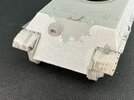
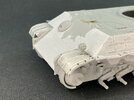
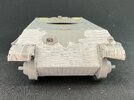
The ribs are 0.5 mm plastic strip that I scraped down on one side to make (more or less) half-round rod, while I made the rivets with a punch and die set. The headlight is from the kit, set on a piece of plastic card glued under the opening I cut in the left mudguard (to match the real tank). I did have to bend and slightly shorten the power cable, because as moulded it doesn't match the real Panther G.
On to the front mudguards. I didn't see myself making these with my limited skills, but luckily, my father was taught metalworking in school long ago, and still enjoys making things from it. A while after I handed him the mudguards I sawed off the model and the aluminium sheet I used for the side skirt rails, he gave me back two copies of them in aluminium



The ribs are 0.5 mm plastic strip that I scraped down on one side to make (more or less) half-round rod, while I made the rivets with a punch and die set. The headlight is from the kit, set on a piece of plastic card glued under the opening I cut in the left mudguard (to match the real tank). I did have to bend and slightly shorten the power cable, because as moulded it doesn't match the real Panther G.
Jakko
Well-Known Member
- Joined
- Oct 9, 2024
- Messages
- 761
With the mudguards added, I can start working on the tool racks on the sides:
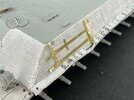
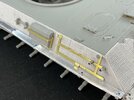
They're not yet done, because I didn't feel like making those little clamps tonight anymore, the ones that German armour modellers all seem to think are so important to add With this kit, you get all of the tools and racks in both plastic and etched brass, but oddly, the bits of tube are not supplied for adding to the etched parts. I made them from 1 mm plastic rod for the upper ones (that the tow cable hooks onto when stowed), and 1.5 mm aluminium tube for the lower ones (for the tow shackle) — but the latter only on the right, because Cuckoo didn't have them on the left. Don't ask me why they're missing, but I can't see them in photographs. What's more, Dragon made two small mistakes with these tubes: the upper one on the plastic part is too long, the lower ones are too thin. For some other details Dragon missed, I used plastic strip.
With this kit, you get all of the tools and racks in both plastic and etched brass, but oddly, the bits of tube are not supplied for adding to the etched parts. I made them from 1 mm plastic rod for the upper ones (that the tow cable hooks onto when stowed), and 1.5 mm aluminium tube for the lower ones (for the tow shackle) — but the latter only on the right, because Cuckoo didn't have them on the left. Don't ask me why they're missing, but I can't see them in photographs. What's more, Dragon made two small mistakes with these tubes: the upper one on the plastic part is too long, the lower ones are too thin. For some other details Dragon missed, I used plastic strip.
I know all of this because I have these:

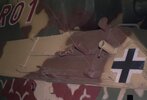
And this is how those tool clasps work:
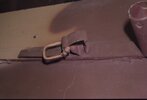
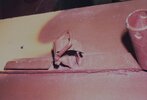

(Photos of the Panther G at Bovington, taken by me in the autumn of 2000. Never throw anything away )
)


They're not yet done, because I didn't feel like making those little clamps tonight anymore, the ones that German armour modellers all seem to think are so important to add
I know all of this because I have these:


And this is how those tool clasps work:



(Photos of the Panther G at Bovington, taken by me in the autumn of 2000. Never throw anything away
Jakko
Well-Known Member
- Joined
- Oct 9, 2024
- Messages
- 761
Now that I've finished building my old-school Tamiya Panzer II and Piranha PWI, I can finally continue with Cuckoo.
On the left side of the turret, a piece of Zimmerit had come off on the real tank. To replicate that accurately, I made a template much like for the hull front, again by tracing over a photograph and printing it out at 1:35 scale. By cutting it out, placing it over the turret side and dabbing paint through it with a brush, I transferred the shape to the model easily enough:
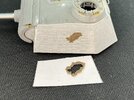
Then I just used a sharp knife to cut around the outside of the damaged patch, and then removed the bit inside that cut:
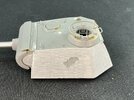
Over the last few days, I've been cleaning up links from a set of Rye Field Model Panther tracks. The Dragon kit I'm using for Cuckoo does have separate links, but they're the kind you have to glue, and I'm not a fan of those, so I bought a set of workable ones instead. The links of this are attached in pairs to a bit of sprue, which is easy and simple to remove. Unfortunately, though, there is also an ejector pin mark between the guide teeth and mould seams on either side of them because the teeth are moulded hollow (another advantage compared to Dragon's tracks).
Here at the front a link that hasn't been cleaned up, and at the rear, one on which I've filed down the seams etc.:
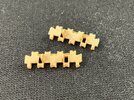
In this box, the links at the front haven't been cleaned up yet, those at the rear have been:

Not the greatest job to be doing, but I've had tracks that needed a lot more work. Once I had cleaned all of them up, I put six links together to see how that goes. The pins are in sets of five on bits of sprue, so you can insert those all at once if you put the links in the jig you can also see in the picture.
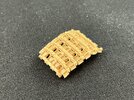
As always, it takes a while to find the best way to build them. One thing I'm disappointed in, is that the pins don't seem to want to stay in by themselves but need a tiny dab of glue. I don't much like that, but what can you do? At least they fit well on the Dragon drive sprockets:
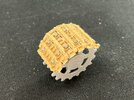
One thing to note is that there are two sets of pins: Nos. 14 and 15, and one of the two goes on the inside and the other on the outside of the track — so they're not the same on both sides of the tank! At first sight there doesn't seem to be any difference between the pins, but there is:
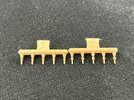
The heads on Nos. 14 are flatter than on Nos. 15, so you need to pay attention which ones you put where.
On the left side of the turret, a piece of Zimmerit had come off on the real tank. To replicate that accurately, I made a template much like for the hull front, again by tracing over a photograph and printing it out at 1:35 scale. By cutting it out, placing it over the turret side and dabbing paint through it with a brush, I transferred the shape to the model easily enough:

Then I just used a sharp knife to cut around the outside of the damaged patch, and then removed the bit inside that cut:

Over the last few days, I've been cleaning up links from a set of Rye Field Model Panther tracks. The Dragon kit I'm using for Cuckoo does have separate links, but they're the kind you have to glue, and I'm not a fan of those, so I bought a set of workable ones instead. The links of this are attached in pairs to a bit of sprue, which is easy and simple to remove. Unfortunately, though, there is also an ejector pin mark between the guide teeth and mould seams on either side of them because the teeth are moulded hollow (another advantage compared to Dragon's tracks).
Here at the front a link that hasn't been cleaned up, and at the rear, one on which I've filed down the seams etc.:

In this box, the links at the front haven't been cleaned up yet, those at the rear have been:

Not the greatest job to be doing, but I've had tracks that needed a lot more work. Once I had cleaned all of them up, I put six links together to see how that goes. The pins are in sets of five on bits of sprue, so you can insert those all at once if you put the links in the jig you can also see in the picture.

As always, it takes a while to find the best way to build them. One thing I'm disappointed in, is that the pins don't seem to want to stay in by themselves but need a tiny dab of glue. I don't much like that, but what can you do? At least they fit well on the Dragon drive sprockets:

One thing to note is that there are two sets of pins: Nos. 14 and 15, and one of the two goes on the inside and the other on the outside of the track — so they're not the same on both sides of the tank! At first sight there doesn't seem to be any difference between the pins, but there is:

The heads on Nos. 14 are flatter than on Nos. 15, so you need to pay attention which ones you put where.
- Joined
- Sep 4, 2022
- Messages
- 1,533
Hmmm, might that be something of a 'back-handed' compliment?You military builders are of another breed
Edbert
Well-Known Member
- Joined
- May 16, 2024
- Messages
- 1,062
I think it was front, back, and both sides a handed compliment.Hmmm, might that be something of a 'back-handed' compliment?
Jakko
Well-Known Member
- Joined
- Oct 9, 2024
- Messages
- 761
For me, it depends. Some tracks are just too difficult to put together (Bronco Sherman tracks, for example) and others don't want to stay together no matter what you try, and I have little patience for either of those. But ones that do fit, I will usually build without too much complaining 
Edbert
Well-Known Member
- Joined
- May 16, 2024
- Messages
- 1,062
I tried a "AFV Kit" Pz-IV track set in plastic. I went back to the rubber bands on that one.For me, it depends. Some tracks are just too difficult to put together (Bronco Sherman tracks, for example) and others don't want to stay together no matter what you try, and I have little patience for either of those. But ones that do fit, I will usually build without too much complaining
The Fruil (sp?) metal tracks for the Panther worked great.
Plastic linked tracks on the Merkava (Meng) and the Bradely (also Meng) went together great.
But I think modern armor is easier to reproduce than the WWII stuff.
Jakko
Well-Known Member
- Joined
- Oct 9, 2024
- Messages
- 761
A Panzer IV is one where I would definitely not use single-piece, soft-plastic tracksI tried a "AFV Kit" Pz-IV track set in plastic. I went back to the rubber bands on that one.
FriulFruil (sp?)
Most modern vehicles have much larger track links, so less fiddly work, yes. These Panther links are a good size too, Sherman tracks are doable, but I wouldn't want to assemble, say, Universal Carrier workable track unless the links just clip together.But I think modern armor is easier to reproduce than the WWII stuff.
Jakko
Well-Known Member
- Joined
- Oct 9, 2024
- Messages
- 761
Because the tracks are on hold while I wait for thicker glue and I also can't continue on the Archer because I'm waiting for someone to print and send me snatch hooks for the tow ropes, I tackled another job I wasn't looking forward to: Cuckoo's tool racks.
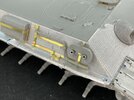
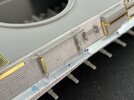
In the first photo, you can see a brass tool clamp — or actually, two of the three parts for one. By the time I had those in position, I really didn't feel like doing the other seven, so I went looking for another way to make them. I found that in cutting off the plastic tools from the clasps they're moulded onto, so that I could drill out the clasps and for the non-round ones, carve the hole bigger with the tip of a knife. That proved much easier than fiddling around with tiny etched parts, so I'm glad I took this route instead. The one at the left front, I cut away after taking the picture and replaced it by a plastic one.
A few details about Cuckoo here:
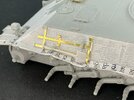


In the first photo, you can see a brass tool clamp — or actually, two of the three parts for one. By the time I had those in position, I really didn't feel like doing the other seven, so I went looking for another way to make them. I found that in cutting off the plastic tools from the clasps they're moulded onto, so that I could drill out the clasps and for the non-round ones, carve the hole bigger with the tip of a knife. That proved much easier than fiddling around with tiny etched parts, so I'm glad I took this route instead. The one at the left front, I cut away after taking the picture and replaced it by a plastic one.
A few details about Cuckoo here:
- At the right front the towing shackle is stowed upside down while the axe and fire extinguisher are missing. During the fighting around Geijsteren there was a squarish object where the latter is supposed to go, but I haven't figured out yet what that was. Towards the end, in Cleve, only the starting crank and the towing shackle were still in this rack.
- At the right rear only the tool for adjusting the idler wheel is still present, but the hammer and crowbar are gone. In Cleve there is a crowbar, but that is in the wrong clasp (the one for the hammer) on the right and it's stuck through the bracket for the hammer's head on the left. The idler adjusting tool is still there in Cleve, in its proper clasp on the right but also stuck through the hammer's bracket on the left.
- At the left front, there is nothing in the rack at all except for a British shovel — not a German one, as can be seen from the T-handle, because German shovels had a knob at the end of the handle. The one on my model comes from a set of British paratroopers from Master Box. I cut the handle in two so I could glue it to either side of the clasp.

Jakko
Well-Known Member
- Joined
- Oct 9, 2024
- Messages
- 761
It was that or buy 3D-printed ones, and I didn't want the expense and waiting time for thoseI like your approach to the clamps.
Now remember that there are working etched ones in 1:35 …The PE three part clamps on my panzer IV were a pain.....and that's 1/16 scale.
Jakko
Well-Known Member
- Joined
- Oct 9, 2024
- Messages
- 761
While I was staring at photos to figure out the crap tied to the sides of the tank, I noticed that there was no Zimmerit in the area covered by the tube for the gun cleaning rods and spare antennas (which was missing on Cuckoo), so I tackled that in the time-honoured manner: open the photo of Cuckoo in Tilburg in Photoshop, cut out the side, correct its perspective and resize to the correct dimensions for the model, then switch to Illustrator to trace over the missing section of Zimmerit and print it out. Then I just had to cut it out and use it as a paint stencil:
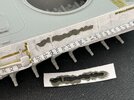
This is not the full length, because in the photo from Tilburg there's something tied to the side of the tank (my working theory is that it's a camouflage net) that obscures the rear part.
All that was left was to cut it out on the model:
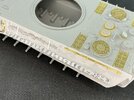
Trickier than expected, partly because the Zimmerit turned out to be glued down quite well and partly because I had to take extra care because of all the other details already attached to the hull. My advice: do this before you stick the Zimmerit to your model The part at the back is speculative, and simply cut to match the rest. I then glued plastic strip into the recesses for the brackets that held the tube, as the remains of those.
The part at the back is speculative, and simply cut to match the rest. I then glued plastic strip into the recesses for the brackets that held the tube, as the remains of those.
I also added the hangers for the spare track links at the back, twelve nice little fiddly bits to clean up, fold and glue down … Now to add pins through some of them, but I don't think I will add those to all of them. So here's some appropriate reference material:
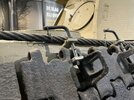
This is the Panther in Overloon, whose details are very similar to Cuckoo's (which is not at all surprising, as they were lost around the same time in the same area). However, those little bolts on the sides will not be on my model

This is not the full length, because in the photo from Tilburg there's something tied to the side of the tank (my working theory is that it's a camouflage net) that obscures the rear part.
All that was left was to cut it out on the model:

Trickier than expected, partly because the Zimmerit turned out to be glued down quite well and partly because I had to take extra care because of all the other details already attached to the hull. My advice: do this before you stick the Zimmerit to your model
I also added the hangers for the spare track links at the back, twelve nice little fiddly bits to clean up, fold and glue down … Now to add pins through some of them, but I don't think I will add those to all of them. So here's some appropriate reference material:

This is the Panther in Overloon, whose details are very similar to Cuckoo's (which is not at all surprising, as they were lost around the same time in the same area). However, those little bolts on the sides will not be on my model
Jakko
Well-Known Member
- Joined
- Oct 9, 2024
- Messages
- 761
Thanks 
Next step is the stowage. I started with the jerrycans, because it's clear what they are and they're easy to find. I built three of them from a Bronco set with British accessories, then put copper wire around them to replicate the string/rope that they were tied up with on the real tank. Here two of them, with the the source of the copper wire:
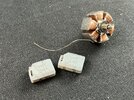
I drilled small holes in the back of the jerrycans to stick the wire into, which you can see on the one on the right, because this is easier than trying to wrap it all the way around. If you do that, it moves around easily and is hard to glue in place.
The wire comes from the rotor of a small electric motor, but I have no idea where that came from
On the tank:
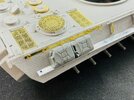
And the left side, with a track link from RFM:
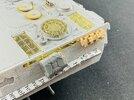
I wanted to drill out the holes for the track pins in it, but that didn't want to cooperate. Oh well, we'll do without, then.
Next step is the stowage. I started with the jerrycans, because it's clear what they are and they're easy to find. I built three of them from a Bronco set with British accessories, then put copper wire around them to replicate the string/rope that they were tied up with on the real tank. Here two of them, with the the source of the copper wire:

I drilled small holes in the back of the jerrycans to stick the wire into, which you can see on the one on the right, because this is easier than trying to wrap it all the way around. If you do that, it moves around easily and is hard to glue in place.
The wire comes from the rotor of a small electric motor, but I have no idea where that came from
On the tank:

And the left side, with a track link from RFM:

I wanted to drill out the holes for the track pins in it, but that didn't want to cooperate. Oh well, we'll do without, then.
Last edited:
Similar threads
- Replies
- 0
- Views
- 274
- Replies
- 41
- Views
- 2K
